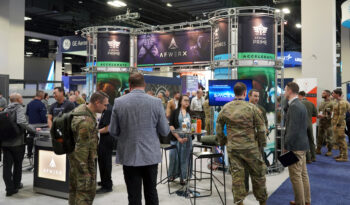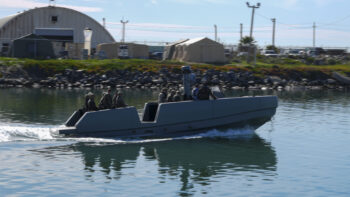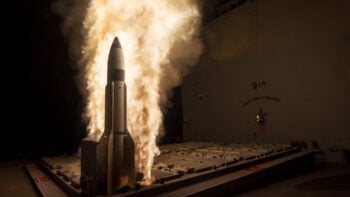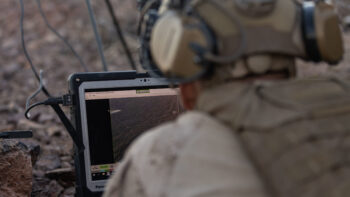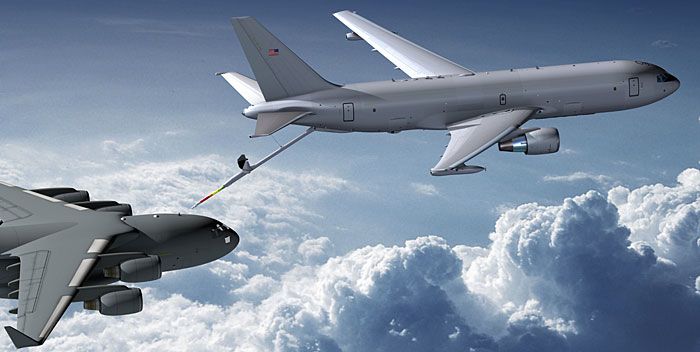
The Air Force plans to use the KC-46 not just as a tanker, but as a communications node.
WASHINGTON: As the first tangible result of the Advanced Battle Management System (ABMS), the Air Force intends to field between at least four new comms pods for the KC-46 by 2023 so the tanker can serve as a kind of flying cell tower between the incompatible radio systems of the F-22 and F-35 fighters.
The end goal isn’t just ‘translation’ software for the fifth-generation fighters, but to continue building out the capabilities the Air Force needs to manage future All Domain Operations — from connectivity to machine-speed decision-making to real-time data sharing among commanders in far flung HQs. To that end, the service’s Rapid Capabilities Office (RCO) — which is now in charge of ABMS acquisition — already is working to define what follow-on capabilities should be next pushed out to Combatant Commanders, according to senior Air Force officials.
The service may field as many as 10 pods. The first four KC-46 pods represent a “minimum viable product” for what the service calls “ABMS Capability Release No. 1,” explained Brig. Gen. Jeffery Valenzia, who heads the service’s new ABMS Cross Functional Team. “However, we also have an objective that we want to get to as many as 10 pods.”
Further, he told reporters at a briefing yesterday, “it’s important to recognize that the development of the pods are focused on this ability to connect the tactical edge, to plug it into the broader command control capability.” The ultimate aim is connectivity writ large, he stressed, not just the development of a series of pods and ‘gateways’ that allow specific machine-to-machine links.
Indeed, Valenzia explained, while 50 percent of the 2021 ABMS investment budget of some $200 million is going into Capability Release 1 (CR-1), the service is already working on defining CR-2.
“At the same time we are also starting to make investments into looking into what we are probably going to focus [on for] Capability Release 2” — which will involve figuring out how to speed command and control decision-making at Northern Command (NORTHCOM) to improve homeland defense.
As I’ve reported, NORTHCOM has been testing artificial intelligence tools to support implementation of ABMS and Joint All Domain Command and Control (JADC2). NORTHCOM head Gen. Glen VanHerck has been a vocal supporter of JADC2, pushing to get his hands on new capabilities as fast as possible to help shore up defenses against what he sees as a growing threat to the homeland from Russia and China.
“The Combatant Commands are still challenged with potential threats over the horizon that they need to characterize and make better decisions on more rapidly,” Gen. David Allvin, Air Force vice chief of staff said. “So, while we work on connectivity through Capability Release Number One, there’s that element of enhanced and accelerated decision-making that we’re really diving deeply into in Capability Release Number Two.”
Indeed, Allvin noted, the Air Force is “feeding in” some ABMS funds to NORTHCOM’s next iteration of its Global Information Dominance Exercise (GIDE) that will be held “in a couple of week” as part of that work.
In addition, Valenzia said, the ABMS program is “making some baseline investments in data management — and, so, the idea of building out a ‘data fabric’.” How can we construct the management of data so that data arrives in the right place, at the right time, in the right format?”
Looking forward to Capability Release 3, a key investment will need to be in in the IT infrastructure to support actually being able to store, process and move the vast amounts of data that will be involved, the officials said.
“We’re looking at how do we solve the Combatant Commanders’ problem of accelerating the kill chain — getting from flying to the target to prosecuting the target as fast as possible. Well, it should be no surprise that in order to move the data faster, you need bigger pipes, you need more bandwidth,” Allvin said.
In answer to a question about overarching ABMS costs, Allvin said that because of the way the program is structured — based on spiral development and a field-test-refine, and field-test-refine again model — “it will be very difficult” to ever come up with a “single cost estimate.”
“The reason why the answer is often unsatisfying as to the cost is because it is a progressive development, in that the more we learn, the more that affects what we’re going to procure in the future,” he elaborated. “So we’re starting with, really, the capabilities-based approach of what ABMS is designed to deliver. And from that, we are developing pieces of the system. And the more we develop the pieces of the system — which one can look at it through the lens of ‘minimum viable products’ that do parts of the entire work of the system — once we’ve learned how to integrate them, and how to scale them, we’ll get a better idea of the cost.”
For this reason, he said, the Air Force is working closely to provide Congress with “transparency” into the processes being used by the RCO, and by Chief Architect Preston Dunlap’s office in developing and experimenting with ABMS-related tech.
Congress has been deeply skeptical of ABMS, chopping the service’s budget request nearly in half in the 2021 defense appropriation.
Allvin said that the Air Force has made a “commitment” to Congress that, “as we learn; as we understand the pieces — the six capability sets that we need to build out the system — as we understand the scope, the scale, and how we anticipate the price being of each of those” … “everything we know, all others will know.”
Those six capabilities sets, as Breaking D readers know, are: Secure Processing; Connectivity; Data Management; Applications; Sensor Integration; and, Effects Integration.


















